Involvement of the Endothelin Receptor Type A in the Cardiovascular Inflammatory Response Following Scorpion Envenomation
Abstract
1. Introduction
2. Results
2.1. ETA Receptors Involvement in Venom-Induced Cytokines
2.2. Role of ETA Receptors in Neutrophil Tissue Infiltration and Metalloproteinase Expression
2.3. ETA Receptor’s Role in the Oxidative Imbalance Caused by Aah Venom
2.4. Implication of ETA Receptors in Tissue Alterations and Metabolic Perturbations Induced by the Venom
3. Discussion
4. Conclusions
5. Materials and Methods
5.1. Venom
5.2. Animals
5.3. Chemical Reagents and Drugs
5.4. Experimental Design
5.5. Cytokine Level Measurement
5.6. Evaluation of the Myeloperoxidase Activity
5.7. Evaluation of Oxidative Stress Biomarkers in Tissues
5.7.1. Determination of Prooxidant Contents and Lipid Peroxidation
5.7.2. Determination of Antioxidant Contents
5.8. Gelatin Zymography
5.9. Enzyme Assays
5.10. Histological Section Analysis
5.11. Statistical Analysis of Data
Author Contributions
Funding
Conflicts of Interest
References
- Gueron, M.; Yaron, R. Cardiovascular manifestations of severe scorpion sting: Clinicopathologic correlations. Chest 1970, 57, 156–162. [Google Scholar] [CrossRef] [PubMed]
- Hering, S.; Jurca, M.; Vichi, F.; Azevedo-Marques, M.; Cupo, P. ‘Reversible cardiomyopathy’in patients with severe scorpion envenoming by Tityus serrulatus: Evolution of enzymatic, electrocardiographic and echocardiographic alterations. Ann. Trop. Paediatr. 1992, 13, 173–182. [Google Scholar] [CrossRef] [PubMed]
- Correa, M.; Sampaio, S.; Lopes, R.; Mancuso, L.; Cunha, O.; Franco, J.; Giglio, J. Biochemical and histopathological alterations induced in rats by Tityus serrulatus scorpion venom and its major neurotoxin tityustoxin-I. Toxicon 1997, 35, 1053–1067. [Google Scholar] [CrossRef]
- Cupo, P.; Hering, S.E. Cardiac troponin I release after severe scorpion envenoming by Tityus serrulatus. Toxicon 2002, 40, 823–830. [Google Scholar] [CrossRef]
- Bahloul, M.; Hamida, C.B.; Chtourou, K.; Ksibi, H.; Dammak, H.; Kallel, H.; Chaari, A.; Chelly, H.; Guermazi, F.; Rekik, N. Evidence of myocardial ischaemia in severe scorpion envenomation. Intensive Care Med. 2004, 30, 461–467. [Google Scholar] [CrossRef]
- Hammoudi-Triki, D.; Lefort, J.; Rougeot, C.; Robbe-Vincent, A.; Bon, C.; Laraba-Djebari, F.; Choumet, V. Toxicokinetic and toxicodynamic analyses of Androctonus australis hector venom in rats: Optimization of antivenom therapy. Toxicol. Appl. Pharmacol. 2007, 218, 205–214. [Google Scholar] [CrossRef]
- Adi-Bessalem, S.; Hammoudi-Triki, D.; Laraba-Djebari, F. Pathophysiological effects of Androctonus australis hector scorpion venom: Tissue damages and inflammatory response. Exp. Toxicol. Pathol. 2008, 60, 373–380. [Google Scholar] [CrossRef]
- Pinto, M.; Borboleta, L.; Melo, M.; Labarrére, C.; Melo, M. Tityus fasciolatus envenomation induced cardio-respiratory alterations in rats. Toxicon 2010, 55, 1132–1137. [Google Scholar] [CrossRef]
- Bakir, F.; Ozkan, O.; Alcigir, M.E.; Vural, S.A. Effects of Androctonus crassicauda scorpion venom on the heart tissue. J. Anim. Vet. Adv. 2012, 11, 2594–2599. [Google Scholar] [CrossRef]
- Nouira, S.; Elatrous, S.; Besbes, L.; Boukef, R.; Devaux, C.; Aubrey, N.; Elayeb, M.; Abroug, F. Neurohormonal activation in severe scorpion envenomation: Correlation with hemodynamics and circulating toxin. Toxicol. Appl. Pharmacol. 2005, 208, 111–116. [Google Scholar] [CrossRef]
- Gueron, M.; Adolph, R.J.; Grupp, I.L.; Gabel, M.; Grupp, G.; Fowler, N.O. Hemodynamic and myocardial consequences of scorpion venom. Am. J. Cardiol. 1980, 45, 979–986. [Google Scholar] [CrossRef]
- Sofer, S.; Gueron, M. Respiratory failure in children following envenomation by the scorpion Leiurus quinquestriatus: Hemodynamic and neurological aspects. Toxicon 1988, 26, 931–939. [Google Scholar] [CrossRef]
- Yarom, R.; Gueron, M.; Braun, K. Scorpion venom cardiomyopathy. Pathobiology 1970, 35, 114–117. [Google Scholar] [CrossRef] [PubMed]
- Elatrous, S.; Nouira, S.; Besbes-Ouanes, L.; Boussarsar, M.; Boukef, R.; Marghli, S.; Abroug, F. Dobutamine in severe scorpion envenomation: Effects on standard hemodynamics, right ventricular performance, and tissue oxygenation. Chest 1999, 116, 748–753. [Google Scholar] [CrossRef] [PubMed]
- Abroug, F.; Ayari, M.; Nouira, S.; Gamra, H.; Boujdaria, R.; Elatrous, S.; Farhat, M.B.; Bouchoucha, S. Assessment of left ventricular function in severe scorpion envenomation: Combined hemodynamic and echo-Doppler study. Intensive Care Med. 1995, 21, 629–635. [Google Scholar] [CrossRef] [PubMed]
- Sifi, A.; Adi-Bessalem, S.; Laraba-Djebari, F. Role of angiotensin II and angiotensin type-1 receptor in scorpion venom-induced cardiac and aortic tissue inflammation. Exp. Mol. Pathol. 2017, 102, 32–40. [Google Scholar] [CrossRef] [PubMed]
- Cajado-Carvalho, D.; Kuniyoshi, A.K.; Duzzi, B.; Iwai, L.K.; Oliveira, Ú.C.d.; Junqueira de Azevedo, I.D.L.M.; Kodama, R.T.; Portaro, F.V. Insights into the hypertensive effects of Tityus serrulatus scorpion venom: Purification of an angiotensin-converting enzyme-like peptidase. Toxins 2016, 8, 348. [Google Scholar] [CrossRef] [PubMed]
- de Oliveira, U.C.; Nishiyama, M.Y., Jr.; dos Santos, M.B.V.; de Paula Santos-da-Silva, A.; de Menezes Chalkidis, H.; Souza-Imberg, A.; Candido, D.M.; Yamanouye, N.; Dorce, V.A.C.; de Junqueira, I.d.L.M. Proteomic endorsed transcriptomic profiles of venom glands from Tityus obscurus and T. serrulatus scorpions. PLoS ONE 2018, 13, e0193739. [Google Scholar] [CrossRef]
- Lamraoui, A.; Adi-Bessalem, S.; Laraba-Djebari, F. Modulation of tissue inflammatory response by histamine receptors in scorpion envenomation pathogenesis: Involvement of H4 receptor. Inflammation 2014, 37, 1689–1704. [Google Scholar] [CrossRef]
- Medjadba, W.; Martin-Eauclaire, M.-F.; Laraba-Djebari, F. Involvement of Kallikrein-Kinin System on Cardiopulmonary Alterations and Inflammatory Response Induced by Purified Aah I Toxin from Scorpion Venom. Inflammation 2016, 39, 290–302. [Google Scholar] [CrossRef]
- Petricevich, V.L. Scorpion venom and the inflammatory response. Mediat. Inflamm. 2010, 2010, 903295. [Google Scholar] [CrossRef] [PubMed]
- Zoccal, K.F.; Paula-Silva, F.W.G.; da Silva Bitencourt, C.; Sorgi, C.A.; Bordon, K.d.C.F.; Arantes, E.C.; Faccioli, L.H. PPAR-g activation by Tityus serrulatus venom regulates lipid body formation and lipid mediator production. Toxicon 2015, 93, 90–97. [Google Scholar] [CrossRef] [PubMed]
- Dousset, E.; Carrega, L.; Steinberg, J.; Clot-Faybesse, O.; Jouirou, B.; Sauze, N.; Devaux, C.; Autier, Y.; Jammes, Y.; Martin-Eauclaire, M. Evidence that free radical generation occurs during scorpion envenomation. Comp. Biochem. Physiol. Part C Toxicol. Pharmacol. 2005, 140, 221–226. [Google Scholar] [CrossRef]
- Martin-Eauclaire, M.-F.; Adi-Bessalem, S.; Hammoudi-Triki, D.; Laraba-Djebari, F.; Bougis, P.E. Serotherapy against Voltage-Gated Sodium Channel-Targeting α-Toxins from Androctonus Scorpion Venom. Toxins 2019, 11, 63. [Google Scholar] [CrossRef] [PubMed]
- Khemili, D.; Laraba-Djebari, F.; Hammoudi-Triki, D. Involvement of Toll-like Receptor 4 in Neutrophil-Mediated Inflammation, Oxidative Stress and Tissue Damage Induced by Scorpion Venom. Inflammation 2020, 43, 155–167. [Google Scholar] [CrossRef]
- Zoccal, K.F.; da Silva Bitencourt, C.; Paula-Silva, F.W.G.; Sorgi, C.A.; Bordon, K.D.C.F.; Arantes, E.C.; Faccioli, L.H. TLR2, TLR4 and CD14 recognize venom-associated molecular patterns from Tityus serrulatus to induce macrophage-derived inflammatory mediators. PLoS ONE 2014, 9, e88174. [Google Scholar] [CrossRef]
- Nakib, I.; Martin-Eauclaire, M.-F.; Laraba-Djebari, F. Involvement of cholinergic and adrenergic receptors in pathogenesis and inflammatory response induced by alpha-neurotoxin Bot III of scorpion venom. Inflammation 2016, 39, 1670–1680. [Google Scholar] [CrossRef]
- Abroug, F.; Nouira, S.; El Atrous, S.; Besbes, L.; Boukef, R.; Boussarsar, M.; Marghli, S.; Eurin, J.; Barthelemy, C.; El Ayeb, M. A canine study of immunotherapy in scorpion envenomation. Intensive Care Med. 2003, 29, 2266–2276. [Google Scholar] [CrossRef]
- Bahloul, M.; Kallel, H.; Rekik, N.; Ben, H.C.; Chelly, H.; Bouaziz, M. Cardiovascular dysfunction following severe scorpion envenomation. Mechanisms and physiopathology. Presse Med. (Paris Fr. 1983) 2005, 34, 115–120. [Google Scholar] [CrossRef]
- Khimji, A.-k.; Rockey, D.C. Endothelin—Biology and disease. Cell. Signal. 2010, 22, 1615–1625. [Google Scholar] [CrossRef]
- Yanagisawa, M.; Kurihara, H.; Kimura, S.; Goto, K.; Masaki, T. A novel peptide vasoconstrictor, endothelin, is produced by vascular endothelium and modulates smooth muscle Ca2+ channels. J. Hypertens. 1988, 6, S188–S191. [Google Scholar] [CrossRef] [PubMed]
- Matsumoto, H.; Suzuki, N.; Onda, H.; Fujino, M. Abundance of endothelin-3 in rat intestine, pituitary gland and brain. Biochem. Biophys. Res. Commun. 1989, 164, 74–80. [Google Scholar] [CrossRef]
- Saida, K.; Kometani, N.; Uchide, T.; Mitsui, Y. Sequence Analysis and Expression of the Mouse Full-Length Vasoactive Intestinal Contractor/Endothelin-2 Gene (EDN2): Comparison with the Endothelin-1 Gene (EDN1); Portland Press Ltd.: Tokyo, Japan, 2002. [Google Scholar]
- Kowalczyk, A.; Kleniewska, P.; Kolodziejczyk, M.; Skibska, B.; Goraca, A. The role of endothelin-1 and endothelin receptor antagonists in inflammatory response and sepsis. Arch. Immunol. Ther. Exp. 2015, 63, 41–52. [Google Scholar] [CrossRef] [PubMed]
- Ding, H.-S.; Yang, J.; Yang, J.; Ding, J.-W.; Chen, P.; Zhu, P. Interleukin-17 contributes to cardiovascular diseases. Mol. Biol. Rep. 2012, 39, 7473–7478. [Google Scholar] [CrossRef]
- Rausch, P.G.; Pryzwansky, K.B.; Spitznagel, J.K. Immunocytochemical identification of azurophilic and specific granule markers in the giant granules of Chediak-Higashi neutrophils. N. Engl. J. Med. 1978, 298, 693–698. [Google Scholar] [CrossRef]
- Klebanoff, S.J. Oxygen metabolism and the toxic properties of phagocytes. Ann. Intern. Med. 1980, 93, 480–489. [Google Scholar] [CrossRef]
- Nagase, H.; Woessner, J.F. Matrix metalloproteinases. J. Biol. Chem. 1999, 274, 21491–21494. [Google Scholar] [CrossRef]
- Zeng, B.; Prasan, A.; Fung, K.; Solanki, V.; Bruce, D.; Freedman, S.; Brieger, D. Elevated circulating levels of matrix metalloproteinase-9 and-2 in patients with symptomatic coronary artery disease. Intern. Med. J. 2005, 35, 331–335. [Google Scholar] [CrossRef]
- Saito, Y.; Watanabe, K.; Fujioka, D.; Nakamura, T.; Obata, J.-e.; Kawabata, K.; Watanabe, Y.; Mishina, H.; Tamaru, S.; Kita, Y. Disruption of group IVA cytosolic phospholipase A2 attenuates myocardial ischemia-reperfusion injury partly through inhibition of TNF-α-mediated pathway. Am. J. Physiol.-Heart Circ. Physiol. 2012, 302, H2018–H2030. [Google Scholar] [CrossRef]
- Wang, M.; Gu, H.; Brewster, B.D.; Huang, C. Role of endogenous testosterone in TNF-induced myocardial injury in males. Int. J. Clin. Exp. Med. 2012, 5, 96. [Google Scholar]
- Pober, J.; Bevilacqua, M.P.; Mendrick, D.L.; Lapierre, L.A.; Fiers, W.; Gimbrone, M.A. Two distinct monokines, interleukin 1 and tumor necrosis factor, each independently induce biosynthesis and transient expression of the same antigen on the surface of cultured human vascular endothelial cells. J. Immunol. 1986, 136, 1680–1687. [Google Scholar]
- Ley, K.; Laudanna, C.; Cybulsky, M.I.; Nourshargh, S. Getting to the site of inflammation: The leukocyte adhesion cascade updated. Nat. Rev. Immunol. 2007, 7, 678–689. [Google Scholar] [CrossRef] [PubMed]
- Griffin, G.K.; Newton, G.; Tarrio, M.L.; Bu, D.-x.; Maganto-Garcia, E.; Azcutia, V.; Alcaide, P.; Grabie, N.; Luscinskas, F.W.; Croce, K.J. IL-17 and TNF-α sustain neutrophil recruitment during inflammation through synergistic effects on endothelial activation. J. Immunol. 2012, 188, 6287–6299. [Google Scholar] [CrossRef] [PubMed]
- Cornelius, D.C.; Wallace, K.; Kiprono, L.; Dhillon, P.; Moseley, J.; LaMarca, B. Endothelin-1 is not a mechanism of IL-17 induced hypertension during pregnancy. Med. J. Obstet. Gynecol. 2013, 1, 1006. [Google Scholar] [PubMed]
- Afzali, B.; Lombardi, G.; Lechler, R.; Lord, G. The role of T helper 17 (Th17) and regulatory T cells (Treg) in human organ transplantation and autoimmune disease. Clin. Exp. Immunol. 2007, 148, 32–46. [Google Scholar] [CrossRef] [PubMed]
- Chen, Q.; Jin, M.; Yang, F.; Zhu, J.; Xiao, Q.; Zhang, L. Matrix metalloproteinases: Inflammatory regulators of cell behaviors in vascular formation and remodeling. Mediat. Inflamm. 2013, 2013, 928315. [Google Scholar] [CrossRef]
- Halliwell, B.; Gutteridge, J.M. Free Radicals in Biology and Medicine; Oxford University Press: New York, NY, USA, 2015. [Google Scholar]
- Meki, A.-R.; El-Dean, Z.M. Serum interleukin-1β, interleukin-6, nitric oxide and α 1-antitrypsin in scorpion envenomed children. Toxicon 1998, 36, 1851–1859. [Google Scholar] [CrossRef]
- Kimura, H.; Sawada, T.; Oshima, S.; Kozawa, K.; Ishioka, T.; Kato, M. Toxicity and roles of reactive oxygen species. Curr. Drug Targets-Inflamm. Allergy 2005, 4, 489–495. [Google Scholar] [CrossRef]
- D’suze, G.; Salazar, V.; Díaz, P.; Sevcik, C.; Azpurua, H.; Bracho, N. Histophatological changes and inflammatory response induced by Tityus discrepans scorpion venom in rams. Toxicon 2004, 44, 851–860. [Google Scholar] [CrossRef]
- Daisley, H.; Alexander, D.; Pitt-Miller, P. Acute myocarditis following Tityus trinitatis envenoming: Morphological and pathophysiological characteristics. Toxicon 1999, 37, 159–165. [Google Scholar] [CrossRef]
- Ruetten, H.; Thiemermann, C. Endothelin-1 stimulates the biosynthesis of tumour necrosis factor in macrophages: ET-receptors, signal transduction and inhibition by dexamethasone. J. Physiol. Pharmacol. Off. J. Pol. Physiol. Soc. 1997, 48, 675–688. [Google Scholar]
- Hofman, F.; Chen, P.; Jeyaseelan, R.; Incardona, F.; Fisher, M.; Zidovetzki, R. Endothelin-1 induces production of the neutrophil chemotactic factor interleukin-8 by human brain-derived endothelial cells. Blood 1998, 92, 3064–3072. [Google Scholar] [CrossRef] [PubMed]
- Gómez-Garre, D.; Guerra, M.; González, E.; López-Farré, A.; Riesco, A.; Caramelo, C.; Escanero, J.; Egido, J. Aggregation of human polymorphonuclear leukocytes by endothelin: Role of platelet-activating factor. Eur. J. Pharmacol. 1992, 224, 167–172. [Google Scholar] [CrossRef]
- Ishizuka, T.; Takamizawa-Matsumoto, M.; Suzuki, K.; Kurita, A. Endothelin-1 enhances vascular cell adhesion molecule-1 expression in tumor necrosis factor α-stimulated vascular endothelial cells. Eur. J. Pharmacol. 1999, 369, 237–245. [Google Scholar] [CrossRef]
- Taleb, S.; Tedgui, A.; Mallat, Z. IL-17 and Th17 cells in atherosclerosis: Subtle and contextual roles. Arterioscler. Thromb. Vasc. Biol. 2015, 35, 258–264. [Google Scholar] [CrossRef]
- Gonon, A.T.; Gourine, A.V.; Middelveld, R.J.; Alving, K.; Pernow, J. Limitation of infarct size and attenuation of myeloperoxidase activity by an endothelin A receptor antagonist following ischaemia and reperfusion. Basic Res. Cardiol. 2001, 96, 454–462. [Google Scholar] [CrossRef]
- Lund, A.K.; Lucero, J.; Lucas, S.; Madden, M.C.; McDonald, J.D.; Seagrave, J.-C.; Knuckles, T.L.; Campen, M.J. Vehicular Emissions Induce Vascular MMP-9 Expression and Activity Associated With Endothelin-1–Mediated Pathways. Arterioscler. Thromb. Vasc. Biol. 2009, 29, 511–517. [Google Scholar] [CrossRef]
- Fini, M.E.; Cook, J.R.; Mohan, R.; Brinckerhoff, C.E. Regulation of matrix metalloproteinase gene expression. Matrix Met. 1998, 299, 356. [Google Scholar]
- Pincus, S.H.; DiNapoli, A.-M.; Schooley, W.R. Superoxide production by eosinophils: Activation by histamine. J. Investig. Dermatol. 1982, 79, 53–57. [Google Scholar] [CrossRef]
- Defraigne, J.-O.; Pincemail, J.; Larbuisson, R.; Blaffart, F.; Limet, R. Cytokine release and neutrophil activation are not prevented by heparin-coated circuits and aprotinin administration. Ann. Thorac. Surg. 2000, 69, 1084–1091. [Google Scholar] [CrossRef]
- Dong, F.; Zhang, X.; Wold, L.E.; Ren, Q.; Zhang, Z.; Ren, J. Endothelin-1 enhances oxidative stress, cell proliferation and reduces apoptosis in human umbilical vein endothelial cells: Role of ETB receptor, NADPH oxidase and caveolin-1. Br. J. Pharmacol. 2005, 145, 323–333. [Google Scholar] [CrossRef] [PubMed]
- Duerrschmidt, N.; Wippich, N.; Goettsch, W.; Broemme, H.-J.; Morawietz, H. Endothelin-1 induces NAD (P) H oxidase in human endothelial cells. Biochem. Biophys. Res. Commun. 2000, 269, 713–717. [Google Scholar] [CrossRef] [PubMed]
- López-Sepúlveda, R.; Gómez-Guzmán, M.; Zarzuelo, M.J.; Romero, M.; Sánchez, M.; Quintela, A.M.; Galindo, P.; O’Valle, F.; Tamargo, J.; Pérez-Vizcaíno, F. Red wine polyphenols prevent endothelial dysfunction induced by endothelin-1 in rat aorta: Role of NADPH oxidase. Clin. Sci. 2011, 120, 321–333. [Google Scholar] [CrossRef] [PubMed]
- Viel, E.C.; Benkirane, K.; Javeshghani, D.; Touyz, R.M.; Schiffrin, E.L. Xanthine oxidase and mitochondria contribute to vascular superoxide anion generation in DOCA-salt hypertensive rats. Am. J. Physiol.-Heart Circ. Physiol. 2008, 295, H281–H288. [Google Scholar] [CrossRef]
- Ozdemir, R.; Parlakpinar, H.; Polat, A.; Colak, C.; Ermis, N.; Acet, A. Selective endothelin a (ET A) receptor antagonist (BQ-123) reduces both myocardial infarct size and oxidant injury. Toxicology 2006, 219, 142–149. [Google Scholar] [CrossRef]
- Goyal, S.; Bharti, S.; Arora, S.; Golechha, M.; Arya, D. Endothelin receptor antagonist BQ-123 ameliorates myocardial ischemic-reperfusion injury in rats: A hemodynamic, biochemical, histopathological and electron microscopic evidence. Biomed. Pharmacother. 2010, 64, 639–646. [Google Scholar] [CrossRef]
- Briyal, S.; Philip, T.; Gulati, A. Endothelin-A receptor antagonists prevent amyloid-β-induced increase in ETA receptor expression, oxidative stress, and cognitive impairment. J. Alzheimer’s Dis. 2011, 23, 491–503. [Google Scholar] [CrossRef]
- Swamy, A.V.; Wangikar, U.; Koti, B.; Thippeswamy, A.; Ronad, P.; Manjula, D. Cardioprotective effect of ascorbic acid on doxorubicin-induced myocardial toxicity in rats. Indian J. Pharmacol. 2011, 43, 507. [Google Scholar] [CrossRef] [PubMed]
- Camici, G.G.; Sudano, I.; Noll, G.; Tanner, F.C.; Lüscher, T.F. Molecular pathways of aging and hypertension. Curr. Opin. Nephrol. Hypertens. 2009, 18, 134–137. [Google Scholar] [CrossRef]
- Elmarakby, A.A.; Loomis, E.D.; Pollock, J.S.; Pollock, D.M. NADPH oxidase inhibition attenuates oxidative stress but not hypertension produced by chronic ET-1. Hypertension 2005, 45, 283–287. [Google Scholar] [CrossRef]
- Sriram, S.; Subramanian, S.; Sathiakumar, D.; Venkatesh, R.; Salerno, M.S.; McFarlane, C.D.; Kambadur, R.; Sharma, M. Modulation of reactive oxygen species in skeletal muscle by myostatin is mediated through NF-κB. Aging Cell 2011, 10, 931–948. [Google Scholar] [CrossRef] [PubMed]
- Donate, P.B.; Cunha, T.M.; Verri, W.A.; Junta, C.M.; Lima, F.O.; Vieira, S.M.; Peres, R.S.; Bombonato-Prado, K.F.; Louzada, P.; Ferreira, S.H. Bosentan, an endothelin receptor antagonist, ameliorates collagen-induced arthritis: The role of TNF-α in the induction of endothelin system genes. Inflamm. Res. 2012, 61, 337–348. [Google Scholar] [CrossRef]
- Krawisz, J.; Sharon, P.; Stenson, W. Quantitative assay for acute intestinal inflammation based on myeloperoxidase activity. Gastroenterology 1984, 87, 1344–1350. [Google Scholar] [CrossRef]
- Sun, J.; Zhang, X.; Broderick, M.; Fein, H. Measurement of nitric oxide production in biological systems by using Griess reaction assay. Sensors 2003, 3, 276–284. [Google Scholar] [CrossRef]
- Pick, E.; Keisari, Y. A simple colorimetric method for the measurement of hydrogen peroxide produced by cells in culture. J. Immunol. Methods 1980, 38, 161–170. [Google Scholar] [CrossRef]
- Ohkawa, H.; Ohishi, N.; Yagi, K. Assay for lipid peroxides in animal tissues by thiobarbituric acid reaction. Anal. Biochem. 1979, 95, 351–358. [Google Scholar] [CrossRef]
- Aebi, H. [13] Catalase in vitro. Methods Enzymol. 1984, 105, 121–126. [Google Scholar]
- Ellman, G.L. Tissue sulfhydryl groups. Arch. Biochem. Biophys. 1959, 82, 70–77. [Google Scholar] [CrossRef]
- Hu, X.; Beeton, C. Detection of functional matrix metalloproteinases by zymography. Jove (J. Vis. Exp.) 2010, 45, e2445. [Google Scholar] [CrossRef]
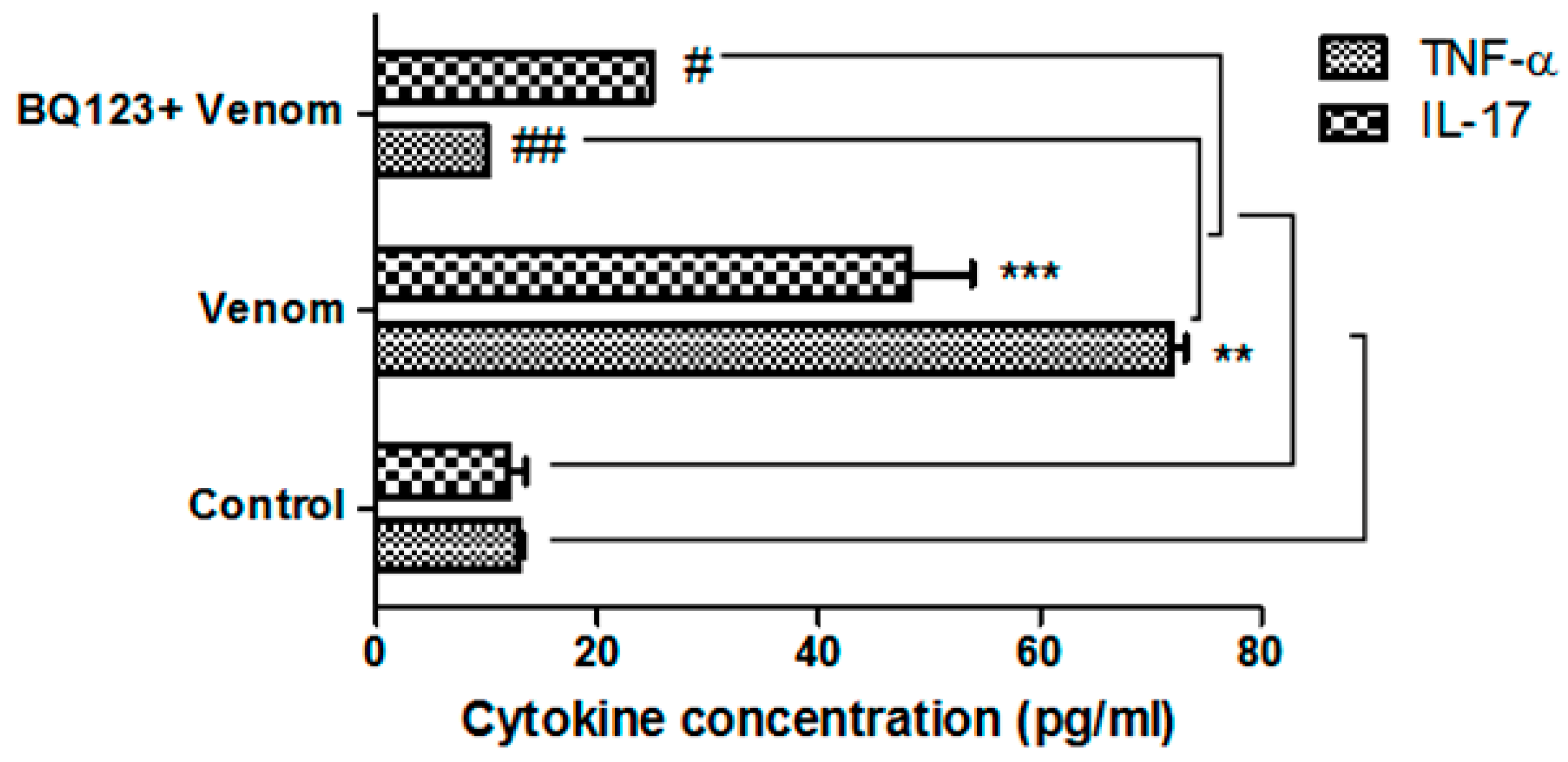
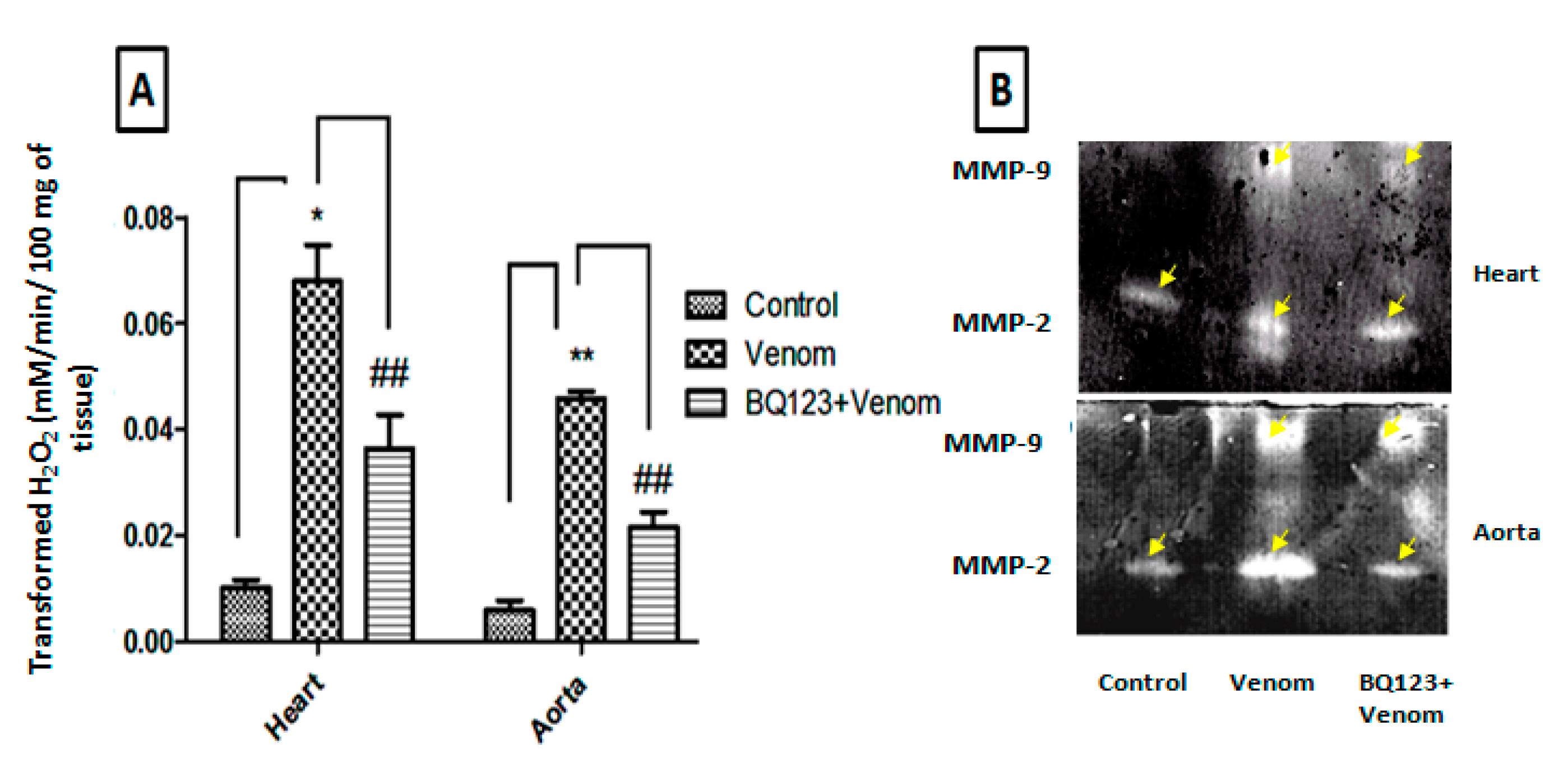
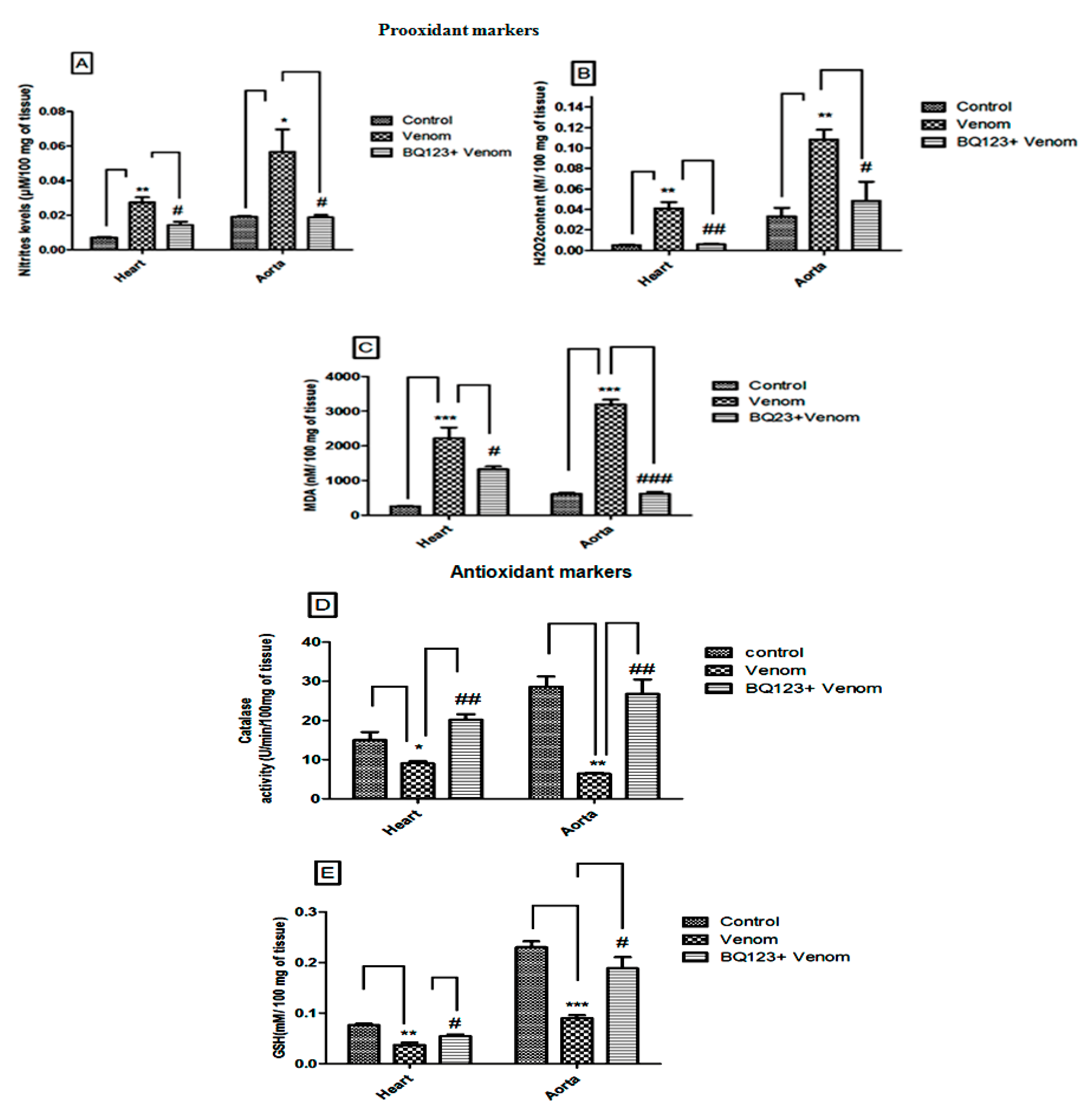
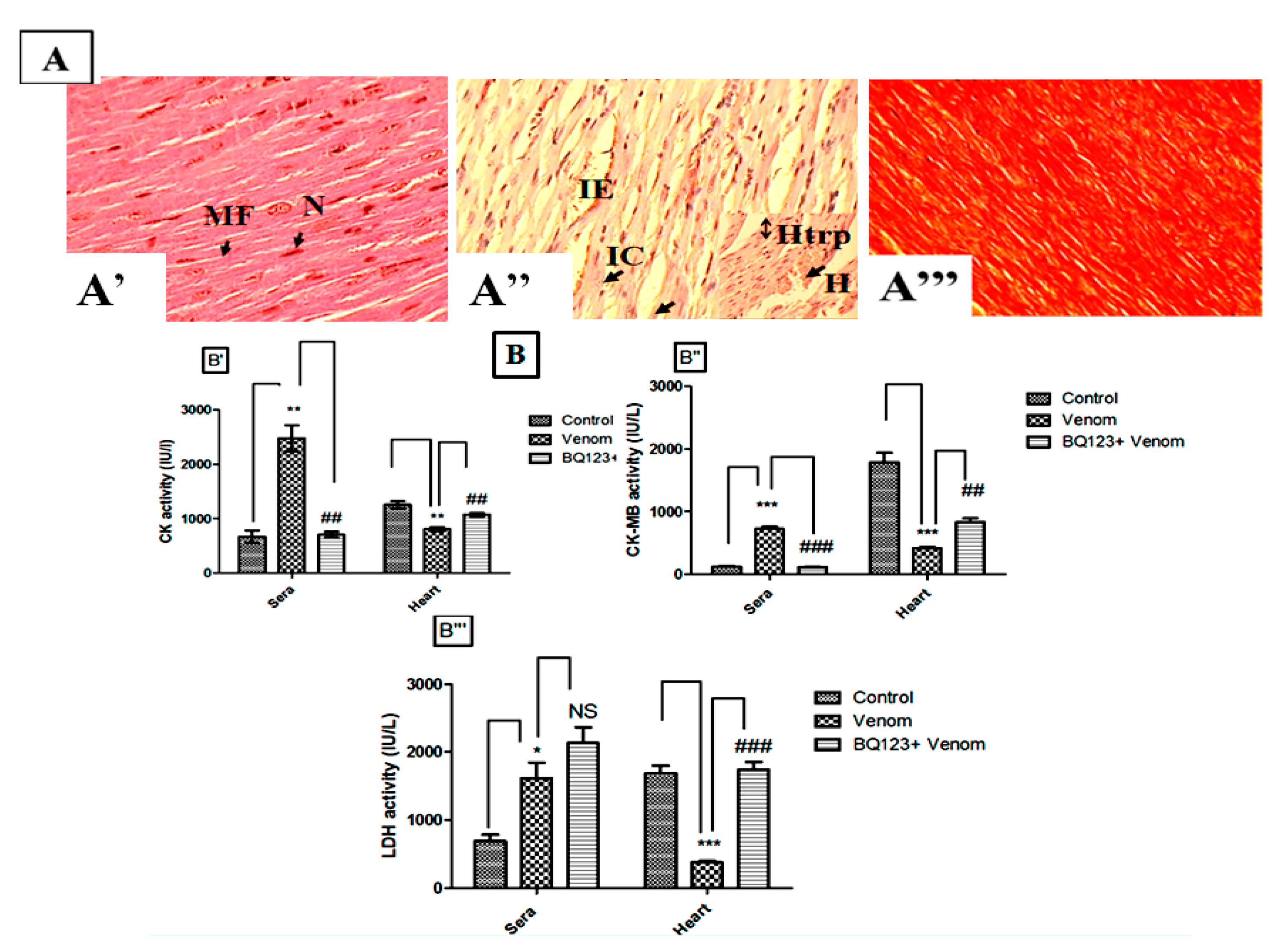
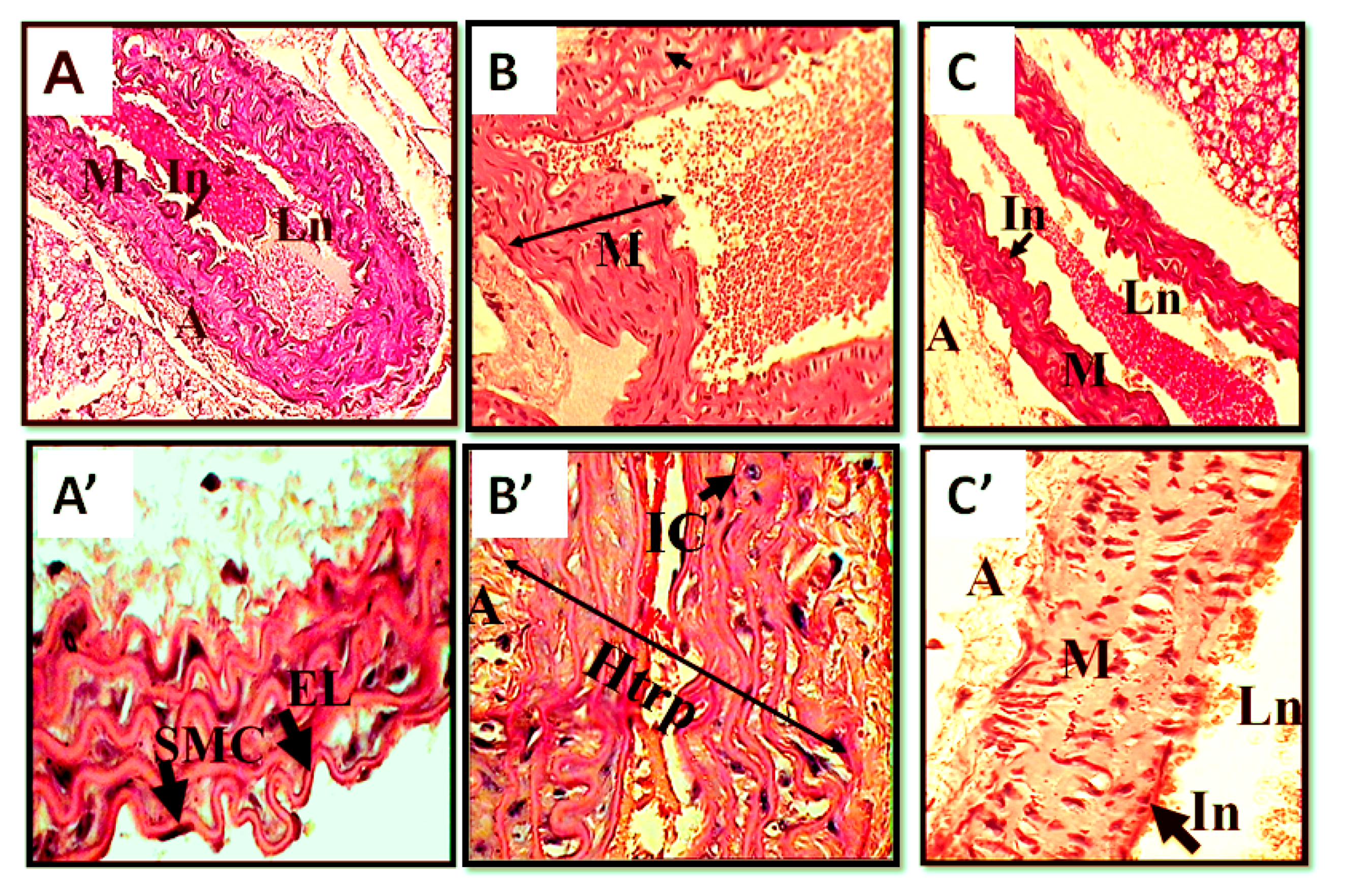
© 2020 by the authors. Licensee MDPI, Basel, Switzerland. This article is an open access article distributed under the terms and conditions of the Creative Commons Attribution (CC BY) license (http://creativecommons.org/licenses/by/4.0/).
Share and Cite
Sifi, A.; Adi-Bessalem, S.; Laraba-Djebari, F. Involvement of the Endothelin Receptor Type A in the Cardiovascular Inflammatory Response Following Scorpion Envenomation. Toxins 2020, 12, 389. https://doi.org/10.3390/toxins12060389
Sifi A, Adi-Bessalem S, Laraba-Djebari F. Involvement of the Endothelin Receptor Type A in the Cardiovascular Inflammatory Response Following Scorpion Envenomation. Toxins. 2020; 12(6):389. https://doi.org/10.3390/toxins12060389
Chicago/Turabian StyleSifi, Amina, Sonia Adi-Bessalem, and Fatima Laraba-Djebari. 2020. "Involvement of the Endothelin Receptor Type A in the Cardiovascular Inflammatory Response Following Scorpion Envenomation" Toxins 12, no. 6: 389. https://doi.org/10.3390/toxins12060389
APA StyleSifi, A., Adi-Bessalem, S., & Laraba-Djebari, F. (2020). Involvement of the Endothelin Receptor Type A in the Cardiovascular Inflammatory Response Following Scorpion Envenomation. Toxins, 12(6), 389. https://doi.org/10.3390/toxins12060389




